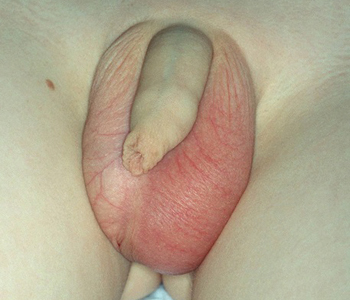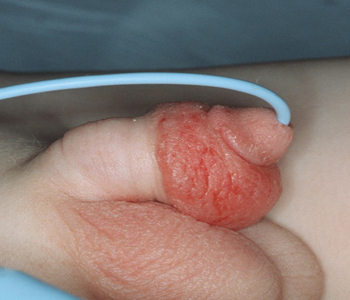An uncommon manifestation of a common summertime problem

A previously healthy 16-year-old male was admitted to the hospital with severe scrotal and penile swelling. The onset of the problem was 6 days earlier, beginning with only some pruritus. However, the next day, he noticed progressive swelling, and he informed his mother, who felt like it was nothing unusual and continued to watch. Two days later, however, the swelling and itching were significantly worse and he was taken to the ED. There, a fungal infection was diagnosed (“jock itch”) and he was given a prescription for fluconazole, along with topical antifungal cream. However, the next day, the swelling had reached a massive size and he returned to the ED, where an ultrasound of the scrotum was performed, ruling out testicular torsion or other intrascrotal abnormality, and he was diagnosed with cellulitis. He was given IV clindamycin plus nafcillin and referred for admission.
Additional history taken in the hospital revealed that the patient spent the day prior to onset playing with friends along a dry creek bed near his home. Additionally, he was seen scratching at a couple of erythematous patches on his face.
What’s Your Diagnosis?
A. Chigger bites
B. Fournier gangrene
C. Epididymitis
D. Contact dermatitis



Examination revealed normal vital signs, along with the swelling of his penis and scrotum (Figures 1 and 2), and some patches of erythema on his face (Figure 3) and proximal thighs (Figure 1). The rest of his exam was completely normal.
There are several historic clues leading to the diagnosis of contact dermatitis (D), most likely poison ivy. Prior to the onset, he spent the day playing outdoors in a wooded area (creek bed), where exposure to plants such as poison ivy is common. He most likely touched or handled some poison ivy or poison oak with his hand, and then transferred the urushiol from the plant to various parts of his body, including his face, proximal thighs and genitalia. This area of the body is highly vascular and prone to swell significantly with otherwise minor insults. Another clue was primarily itching rather than pain or evidence of trauma. Antibiotics were stopped in this patient, and he was treated with systemic steroids. He rapidly improved and was discharged on day 4 (Figure 4).
An ultrasound of the scrotum can almost always diagnose testicular torsion or epididymitis (Figure 5), both of which are going to result in swelling, significant pain and usually overlying erythema, but if there is lingering concern, a urologist should be consulted.
The chigger mite (Eutrombicula alfreddugesi), ANOTHER summertime problem, is very common in the southern states and occasionally referred to as mowers’ mites or harvest mites. These very small, red mites usually live in tall weeds such as Johnson grass, but they can be found in the grass of anyone’s backyard.





Unlike the scabies mite, the chigger mite takes a blood meal and disengages (hops off). There are products in the mite’s saliva that can provoke a reaction with intense pruritus. They get on the legs and ascend to the groin area, particularly on boys, where they can bite and cause significant swelling (Figure 6). As bad as this looks, it is self-limiting and requires no special treatment, including catheterization. The need for catheterization is virtually unheard of, but commonly performed. I have never seen, read or heard of urinary obstruction due to the swelling of chigger bites. The itching is usually treated with oral Benadryl. Secondary infections are very uncommon, but if the patient scratches open a port of entry, Staphylococcus aureus or other organisms can establish an infection (Figure 7).
Fournier gangrene is a severe, necrotizing infection of the perineum (Figure 8), usually associated with poor hygiene, poor health and nutrition, immune deficiency, or trauma. It typically is a mixed infection with aerobes and anaerobes normally found colonizing this area of the body. The approach to therapy is usually with broad-spectrum antibiotics against Gram-negative and Gram-positive organisms, as well as aggressive surgical debridement. Fortunately, it is very uncommon in children.
Comment: In the May column, I showed an unusual case of contact dermatitis of the popliteal area, mistaken for an infection. Similar to the case shown here, the clue was in the history. Some things never change.
- For more information:
- James H. Brien, DO, is with the department of infectious diseases at McLane Children’s Hospital, Baylor Scott & White Health, and an adjunct professor of pediatrics at Texas A&M College of Medicine in Temple, Texas. He also is a member of the Infectious Diseases in Children Editorial Board. Brien can be reached at jhbrien@aol.com.
Disclosure: Brien reports no relevant financial disclosures.
